Power Drill Craniostomy for Bedside Intracranial Access in Traumatic Brain Injury Patients
Abstract
1. Introduction
2. Materials and Methods
2.1. Study Design and Ethics
2.2. Demographic and Outcome Measures
2.3. Drill Specifications and Operative Technique
2.4. Mechanical Testing and Cost Comparison
3. Results
Case Presentations
4. Discussion
5. Future Directions
6. Conclusions
Author Contributions
Funding
Institutional Review Board Statement
Informed Consent Statement
Data Availability Statement
Conflicts of Interest
References
- Kompanje, E.J.O.; Delwel, E.J. The First Description of a Device for Repeated External Ventricular Drainage in the Treatment of Congenital Hydrocephalus, Invented in 1744 by Claude-Nicolas Le Cat. Pediatr. Neurosurg. 2003, 39, 10–13. [Google Scholar] [CrossRef]
- Srinivasan, V.M.; O’Neill, B.R.; Jho, D.; Whiting, D.M.; Oh, M.Y. The History of External Ventricular Drainage. J. Neurosurg. 2014, 120, 228–236. [Google Scholar] [CrossRef] [PubMed]
- Kellie, G. An Account of the Appearances Observed in the Dissection of Two of Three Individuals Presumed to Have Perished in the Storm of the 3d, and Whose Bodies Were Discovered in the Vicinity of Leith on the Morning of the 4th, November 1821; with Some Reflections on the Pathology of the Brain: Part I. Trans. Med. Chir. Soc. Edinb. 1824, 1, 84–122. [Google Scholar] [PubMed]
- Dossani, R.H.; Patra, D.P.; Terrell, D.L.; Willis, B. Placement of an External Ventricular Drain. N. Engl. J. Med. 2021, 384, e3. [Google Scholar] [CrossRef] [PubMed]
- Carney, N.; Totten, A.M.; O’Reilly, C.; Ullman, J.S.; Hawryluk, G.W.J.; Bell, M.J.; Bratton, S.L.; Chesnut, R.; Harris, O.A.; Kissoon, N.; et al. Guidelines for the Management of Severe Traumatic Brain Injury, Fourth Edition. Neurosurgery 2017, 80, 6–15. [Google Scholar] [CrossRef]
- Fried, H.I.; Nathan, B.R.; Rowe, A.S.; Zabramski, J.M.; Andaluz, N.; Bhimraj, A.; Guanci, M.M.; Seder, D.B.; Singh, J.M. The Insertion and Management of External Ventricular Drains: An Evidence-Based Consensus Statement: A Statement for Healthcare Professionals from the Neurocritical Care Society. Neurocrit. Care 2016, 24, 61–81. [Google Scholar] [CrossRef]
- Rowe, A.S.; Rinehart, D.R.; Lezatte, S.; Langdon, J.R. Intracerebral Hemorrhage after External Ventricular Drain Placement: An Evaluation of Risk Factors for Post-Procedural Hemorrhagic Complications. BMC Neurol. 2018, 18, 22. [Google Scholar] [CrossRef]
- Majmundar, N.; Sarris, C.; Shastri, D.; Doran, J.; Gandhi, C.; Assina, R. Hemorrhagic Complications of External Ventriculostomy in the Aspirin and P2Y12 Response Assay Era. World Neurosurg. 2019, 122, e961–e968. [Google Scholar] [CrossRef]
- Miller, C.; Tummala, R.P. Risk Factors for Hemorrhage Associated with External Ventricular Drain Placement and Removal. J. Neurosurg. 2017, 126, 289–297. [Google Scholar] [CrossRef]
- Sorinola, A.; Buki, A.; Sandor, J.; Czeiter, E. Risk Factors of External Ventricular Drain Infection: Proposing a Model for Future Studies. Front. Neurol. 2019, 10, 226. [Google Scholar] [CrossRef]
- Pease, M.; Nwachuku, E.; Goldschmidt, E.; Elmer, J.; Okonkwo, D.O. Complications from Multimodal Monitoring Do Not Affect Long-Term Outcomes in Severe Traumatic Brain Injury. World Neurosurg. 2022, 161, e109–e117. [Google Scholar] [CrossRef] [PubMed]
- Brain Trauma Foundation; American Association of Neurological Surgeons; Congress of Neurological Surgeons. Guidelines for the Management of Severe Traumatic Brain Injury. J. Neurotrauma 2007, 24 (Suppl. S1), S1–S106. [Google Scholar]
- Caird, J.D.; Choudhari, K.A. “Plunging” during Burr Hole Craniostomy: A Persistent Problem amongst Neurosurgeons in Britain and Ireland. Br. J. Neurosurg. 2003, 17, 509–512. [Google Scholar] [CrossRef]
- Jochems, D.; van Rein, E.; Niemeijer, M.; van Heijl, M.; van Es, M.A.; Nijboer, T.; Leenen, L.P.H.; Houwert, R.M.; van Wessem, K.J.P. Incidence, Causes and Consequences of Moderate and Severe Traumatic Brain Injury as Determined by Abbreviated Injury Score in the Netherlands. Sci. Rep. 2021, 11, 19985. [Google Scholar] [CrossRef]
- Yue, J.K.; Satris, G.G.; Dalle Ore, C.L.; Huie, J.R.; Deng, H.; Winkler, E.A.; Lee, Y.M.; Vassar, M.J.; Taylor, S.R.; Schnyer, D.M.; et al. Polytrauma Is Associated with Increased Three- and Six-Month Disability after Traumatic Brain Injury: A TRACK-TBI Pilot Study. Neurotrauma Rep. 2020, 1, 32–41. [Google Scholar] [CrossRef]
- Deng, H.; Luy, D.D.; Abou-Al-Shaar, H.; Yue, J.K.; Zinn, P.O.; Puccio, A.M.; Okonkwo, D.O. Critical Care for Concomitant Severe Traumatic Brain Injury and Acute Spinal Cord Injury in the Polytrauma Patient: Illustrative Case. J. Neurosurg. Case Lessons 2022, 3. [Google Scholar] [CrossRef] [PubMed]
- Alvi, A.; Doherty, T.; Lewen, G. Facial Fractures and Concomitant Injuries in Trauma Patients. Laryngoscope 2003, 113, 102–106. [Google Scholar] [CrossRef]
- Deng, H.; Yue, J.K.; Winkler, E.A.; Dhall, S.S.; Manley, G.T.; Tarapore, P.E. Adult Firearm-Related Traumatic Brain Injury in United States Trauma Centers. J. Neurotrauma 2019, 36, 322–337. [Google Scholar] [CrossRef]
- Deng, H.; Yue, J.K.; Winkler, E.A.; Dhall, S.S.; Manley, G.T.; Tarapore, P.E. Pediatric Firearm-Related Traumatic Brain Injury in United States Trauma Centers. J. Neurosurg. Pediatr. 2019, 24, 498–508. [Google Scholar] [CrossRef]
- Carolus, A.; Richter, W.; Fritzen, C.-P.; Schmieder, K.; Brenke, C. Experimental Investigations of a Manually versus an Electrically Driven Skull Drill for Bedside Usage. PLoS ONE 2019, 14, e0215171. [Google Scholar] [CrossRef]
- Zhang, J.; Zhang, F.; Dong, J.-F. Coagulopathy Induced by Traumatic Brain Injury: Systemic Manifestation of a Localized Injury. Blood 2018, 131, 2001–2006. [Google Scholar] [CrossRef] [PubMed]
- Deng, H.; Yue, J.K.; Durcanova, B.; Sadjadi, J. Emergent Neurosurgical Management of a Rapidly Deteriorating Patient with Acute Intracranial Hemorrhage and Alcohol-Related Thrombocytopenia. J. Neurosci. Rural Pract. 2018, 9, 625–627. [Google Scholar] [CrossRef] [PubMed]
- Vogel, T.W.; Dlouhy, B.J.; Howard, M.A., 3rd. Don’t Take the Plunge: Avoiding Adverse Events with Cranial Perforators. J. Neurosurg. 2011, 115, 570–575. [Google Scholar] [CrossRef]
- Yue, J.K.; Rick, J.W.; Deng, H.; Feldman, M.J.; Winkler, E.A. Efficacy of Decompressive Craniectomy in the Management of Intracranial Pressure in Severe Traumatic Brain Injury. J. Neurosurg. Sci. 2019, 63, 425–440. [Google Scholar] [CrossRef]
- O’Leary, S.T.; Kole, M.K.; Hoover, D.A.; Hysell, S.E.; Thomas, A.; Shaffrey, C.I. Efficacy of the Ghajar Guide Revisited: A Prospective Study. J. Neurosurg. 2000, 92, 801–803. [Google Scholar] [CrossRef]
- Bota, D.P.; Lefranc, F.; Vilallobos, H.R.; Brimioulle, S.; Vincent, J.-L. Ventriculostomy-Related Infections in Critically Ill Patients: A 6-Year Experience. J. Neurosurg. 2005, 103, 468–472. [Google Scholar] [CrossRef] [PubMed]
- Ramanan, M.; Lipman, J.; Shorr, A.; Shankar, A. A Meta-Analysis of Ventriculostomy-Associated Cerebrospinal Fluid Infections. BMC Infect. Dis. 2015, 15, 3. [Google Scholar] [CrossRef]
- Lozier, A.P.; Sciacca, R.R.; Romagnoli, M.F.; Connolly, E.S., Jr. Ventriculostomy-Related Infections: A Critical Review of the Literature. Neurosurgery 2002, 51, 170–181, discussion 181–182. [Google Scholar] [CrossRef]
- Zabramski, J.M.; Whiting, D.; Darouiche, R.O.; Horner, T.G.; Olson, J.; Robertson, C.; Hamilton, A.J. Efficacy of Antimicrobial-Impregnated External Ventricular Drain Catheters: A Prospective, Randomized, Controlled Trial. J. Neurosurg. 2003, 98, 725–730. [Google Scholar] [CrossRef]
- Root, B.K.; Barrena, B.G.; Mackenzie, T.A.; Bauer, D.F. Antibiotic Impregnated External Ventricular Drains: Meta and Cost Analysis. World Neurosurg. 2016, 86, 306–315. [Google Scholar] [CrossRef]
- Mallucci, C.L.; Jenkinson, M.D.; Conroy, E.J.; Hartley, J.C.; Brown, M.; Dalton, J.; Kearns, T.; Moitt, T.; Griffiths, M.J.; Culeddu, G.; et al. Antibiotic or Silver versus Standard Ventriculoperitoneal Shunts (BASICS): A Multicentre, Single-Blinded, Randomised Trial and Economic Evaluation. Lancet 2019, 394, 1530–1539. [Google Scholar] [CrossRef] [PubMed]
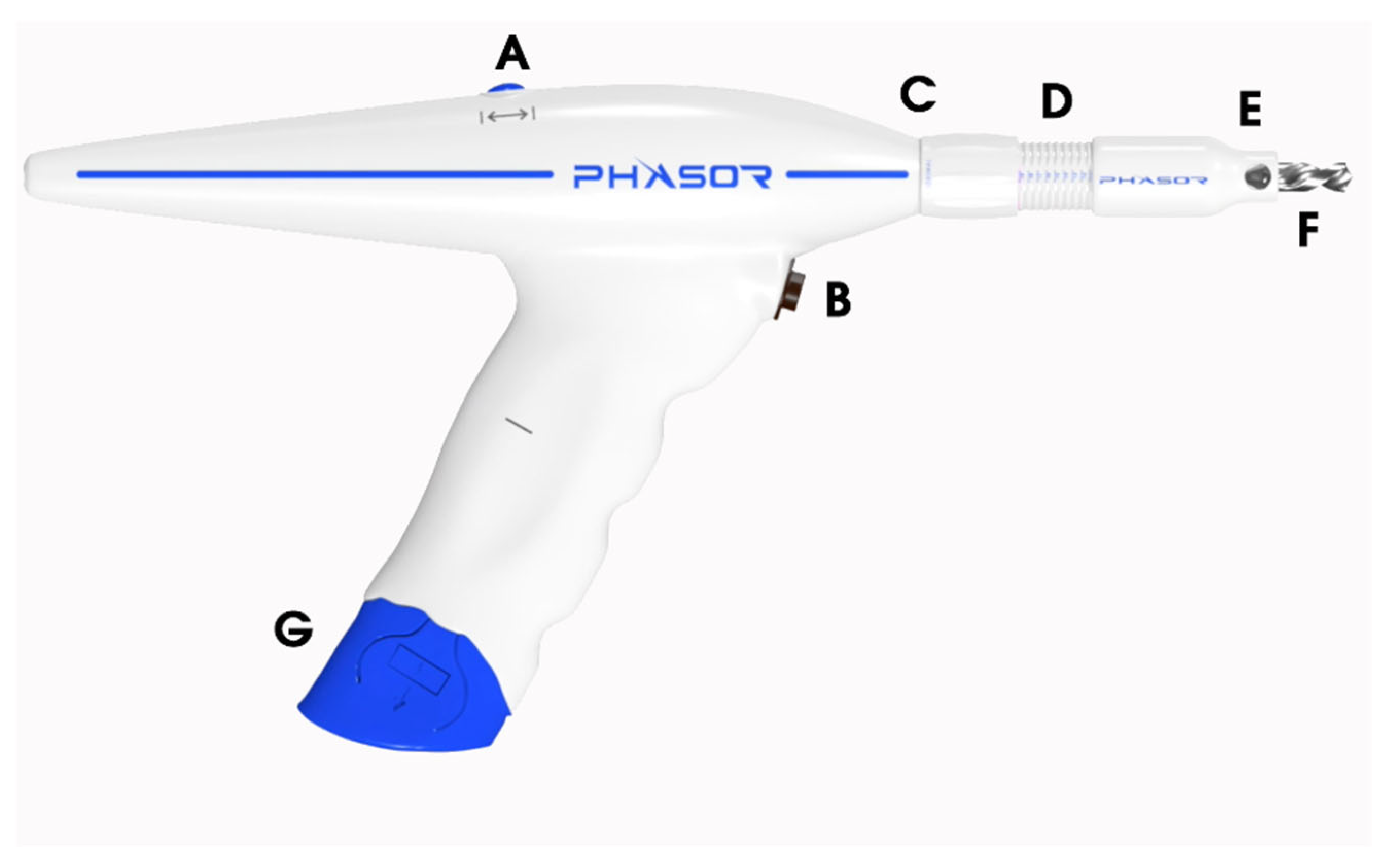
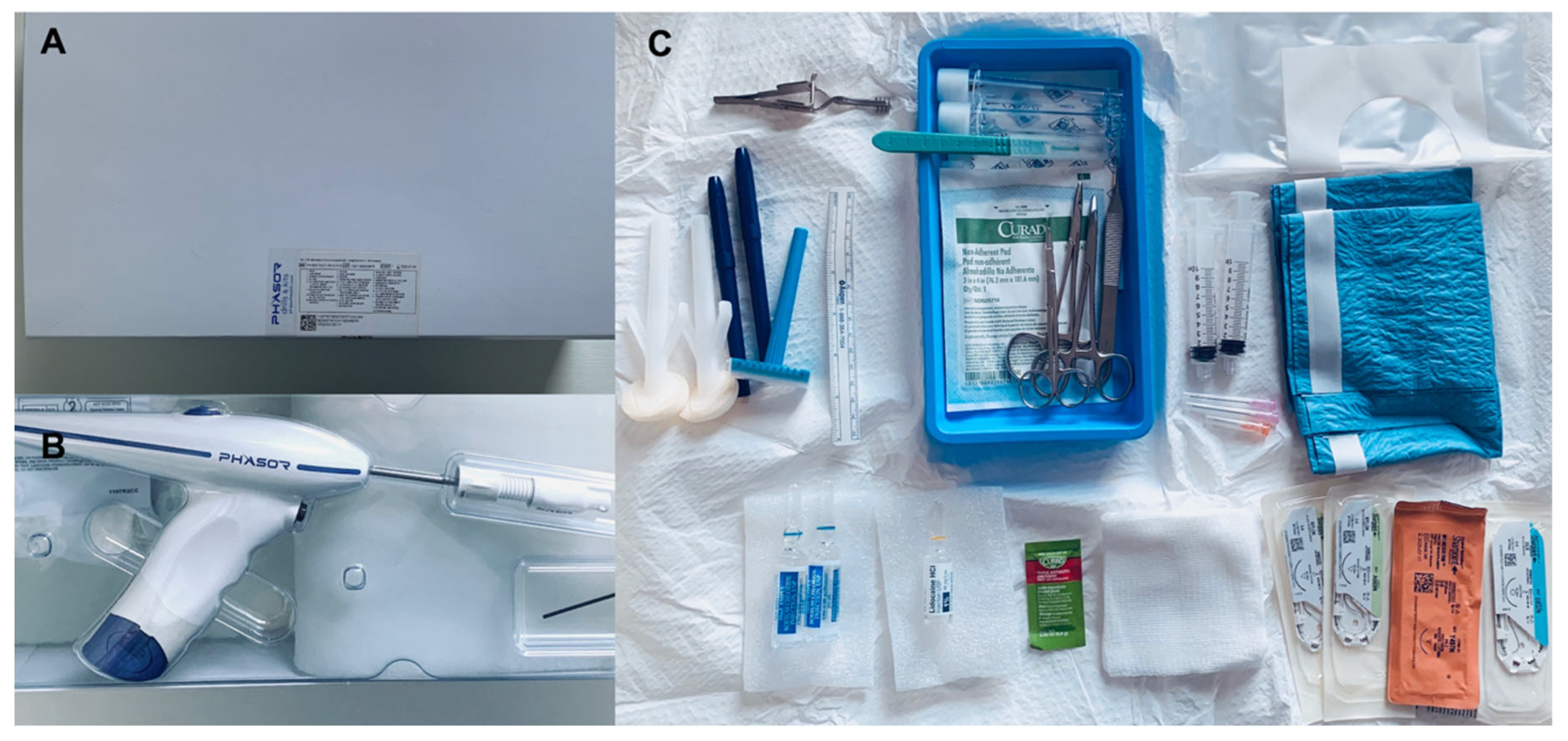
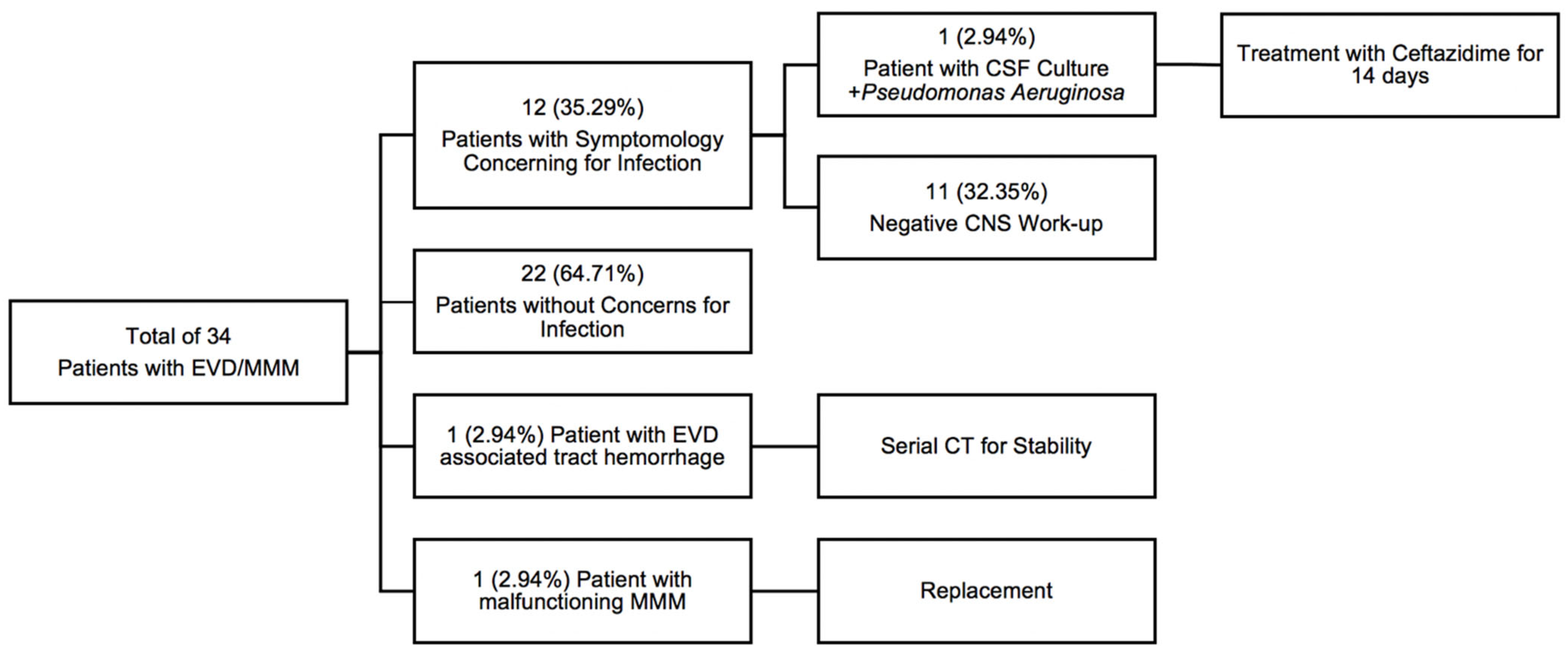
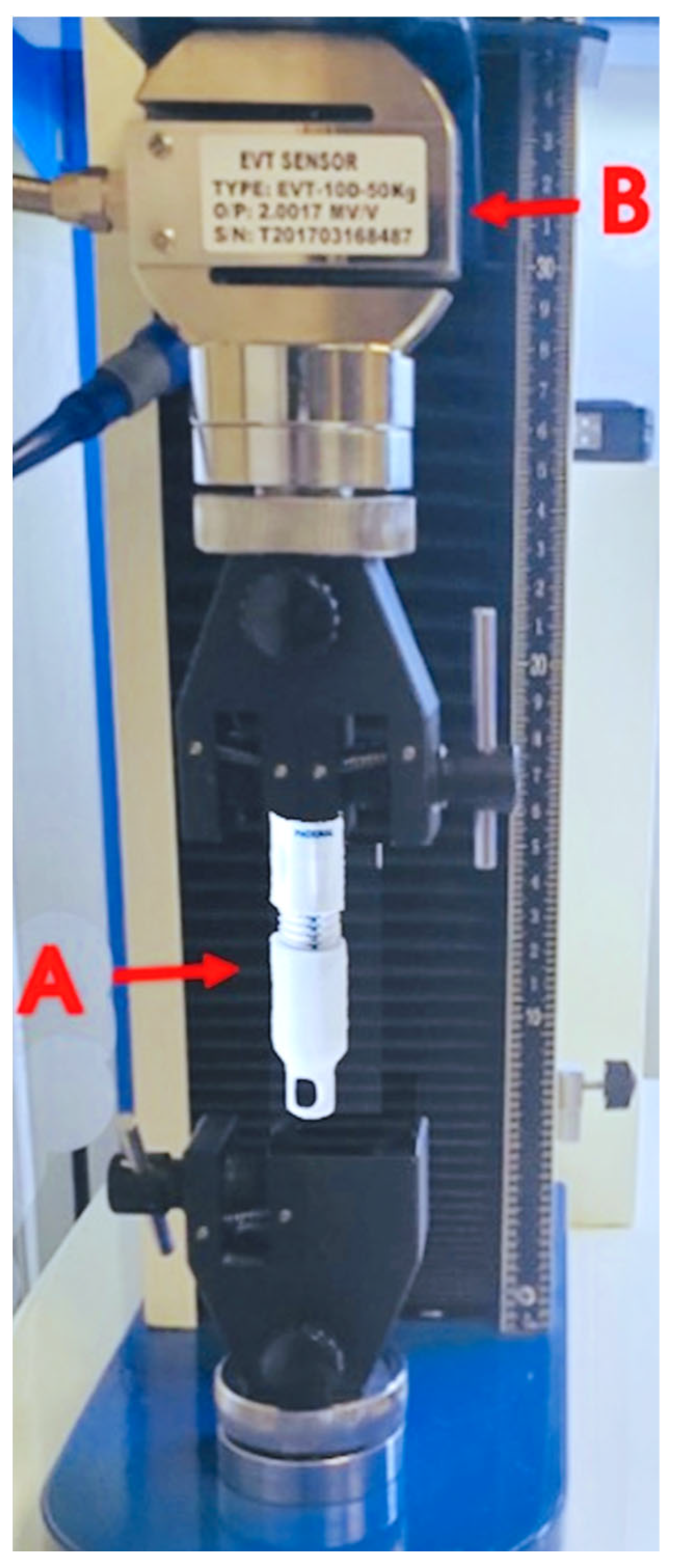
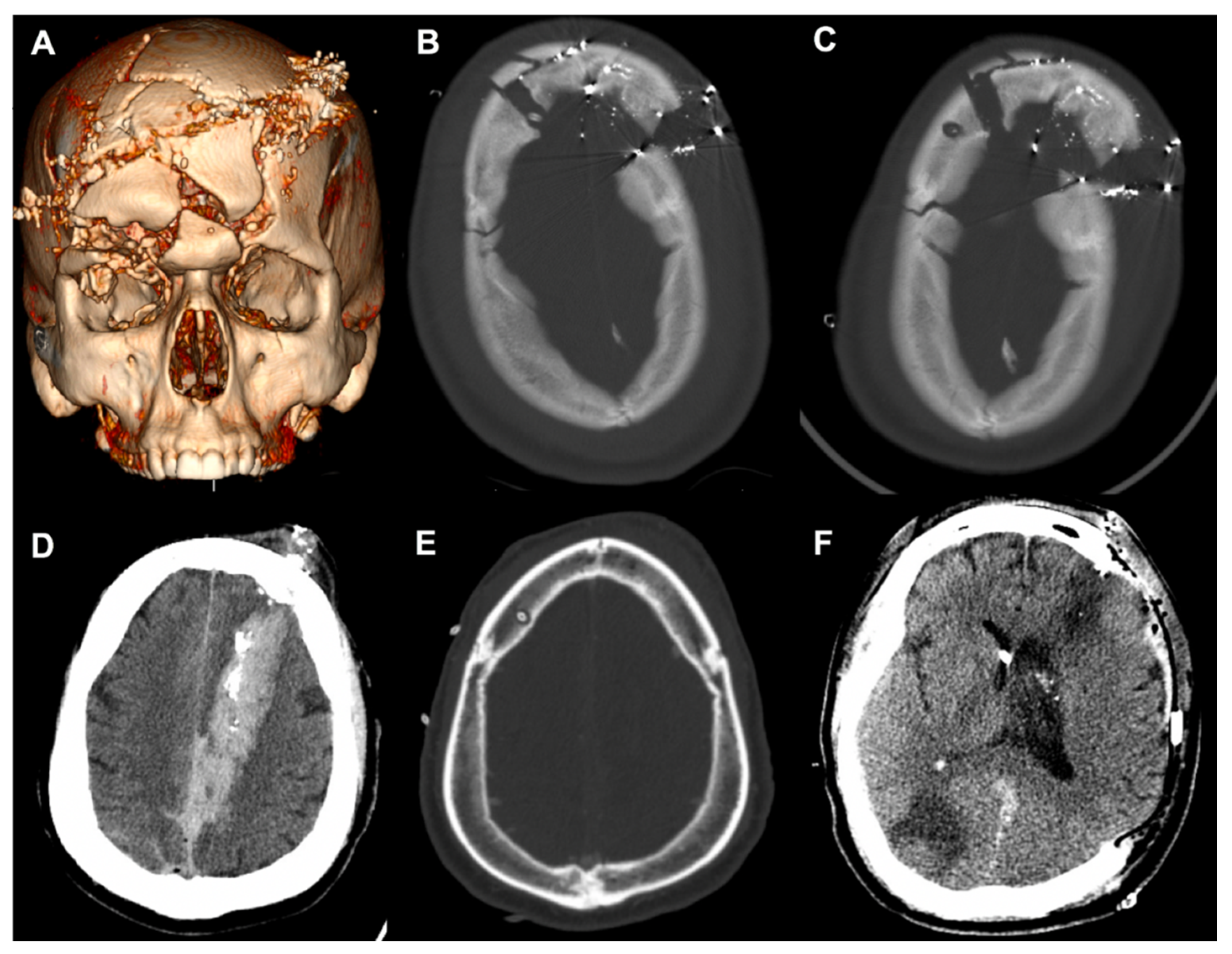
| Type of Drill Bit | Diameter (mm) | Maximum Length (mm) | Neurological Procedures |
|---|---|---|---|
| 1a | 2.4 | 70 | Cervical lateral mass screw cannulation |
| 1b | 2.4 | 210 | SEPS placement |
| 2a | 2.7 | 70 | Natus Camino and Spiegelberg ICP monitors |
| 2b | 2.7 | 210 | Brainlab Varioguide biopsy |
| 3 | 3.2 | 210 | LITT, SEPS placement, regular EVD catheter (3 mm) |
| 4 | 4.5 | 70 | Raumedic ICP monitor, regular EVD catheter (3 mm), and large EVD catheter (3.3–3.4 mm) |
| 5 * | 5.3 | 70 | Hemedex quad-lumen bolt kit, regular EVD catheter (3 mm), and large EVD catheter (3.3–3.4 mm) |
| 6 | 5.8 | 70 | SEPS procedure, regular EVD catheter (3 mm), and large EVD catheter (3.3–3.4 mm) |
| Participant Characteristics | Overall Cohort (N = 34) |
|---|---|
| Mean age in years (SD, range) | 50.7 (18.9, 17–78) |
| Sex | |
| Male | 27 (79.41%) |
| Female | 7 (20.59%) |
| Race | |
| White | 27 (79.41%) |
| Black | 4 (11.77%) |
| Other | 3 (8.82%) |
| Mechanism of Injury | |
| Fall | 15 (44.12%) |
| Motor vehicle accident | 8 (23.53%) |
| Motorcycle accident | 5 (14.71%) |
| Gunshot wound | 4 (11.77%) |
| Other | 2 (5.88%) |
| Pre-Hospital Cardiac Arrest | |
| Yes | 2 (5.88%) |
| No | 32 (94.12%) |
| Injury Severity Score | |
| Mean (SD, range) | 25.50 (6.73, 13–43) |
| 1–15 | 2 (5.88%) |
| 16–24 | 9 (26.47%) |
| 25–49 | 23 (67.65%) |
| 50–75 | 0 |
| Initial GCS Score | |
| Median (range) | 6 (3–10) |
| 3–8 | 29 (85.29%) |
| 9–12 | 5 (14.71%) |
| 13–15 | 0 |
| Surgical Decompression | |
| Yes | 30 (88.24%) |
| No | 4 (11.76%) |
| EVD | |
| Mean time to EVD in days (SD, range) | 0.94 (1.74, 0–8) |
| Mean duration in days (SD, range) | 6.90 (4.27, 1–19) |
| Quad-lumen MMM | |
| Yes | 23 (67.65%) |
| No | 11 (32.35%) |
| Unit # | Before Compression (mm) | During Compression (mm) | Difference (mm) | Signs of Breakage/Crack (Y/N) |
|---|---|---|---|---|
| 1 | 73.38 | 73.17 | 0.21 | N |
| 2 | 73.77 | 73.71 | 0.06 | N |
| 3 | 74.18 | 73.84 | 0.34 | N |
| 4 | 73.84 | 73.69 | 0.15 | N |
| 5 | 73.82 | 73.79 | 0.03 | N |
| 6 | 73.81 | 73.48 | 0.33 | N |
| 7 | 74.17 | 73.96 | 0.21 | N |
| 8 | 74.01 | 73.89 | 0.12 | N |
| Overall | 73.87 | 73.69 | 0.18 | N |
| Quantity | Unit Cost (USD) | Total Cost (USD) | |
|---|---|---|---|
| Material | |||
| Cranial access kit | 1 | 295.00 | 295.00 |
| Chloraprep applicator | 2 | 3.03 | 6.06 |
| CSR wrap | 1 | 1.19 | 1.19 |
| Marker/ruler set | 1 | 2.19 | 2.19 |
| Suture: 3-0 silk | 1 | 4.41 | 4.41 |
| Suture: 3-0 nylon | 2 | 2.98 | 5.96 |
| Suture: 4-0 monofilament | 1 | 6.17 | 6.17 |
| Skin stapler | 1 | 7.50 | 7.50 |
| Telfa dressing | 1 | 0.22 | 0.22 |
| Sterile saline flush | 2 | 0.70 | 1.40 |
| Total cost using conventional kit | 330.10 | ||
| Total cost using power kit | 395.00 |
Disclaimer/Publisher’s Note: The statements, opinions and data contained in all publications are solely those of the individual author(s) and contributor(s) and not of MDPI and/or the editor(s). MDPI and/or the editor(s) disclaim responsibility for any injury to people or property resulting from any ideas, methods, instructions or products referred to in the content. |
© 2023 by the authors. Licensee MDPI, Basel, Switzerland. This article is an open access article distributed under the terms and conditions of the Creative Commons Attribution (CC BY) license (https://creativecommons.org/licenses/by/4.0/).
Share and Cite
Deng, H.; Puccio, D.J.; Anand, S.K.; Yue, J.K.; Hudson, J.S.; Legarreta, A.D.; Wei, Z.; Okonkwo, D.O.; Puccio, A.M.; Nwachuku, E.L. Power Drill Craniostomy for Bedside Intracranial Access in Traumatic Brain Injury Patients. Diagnostics 2023, 13, 2434. https://doi.org/10.3390/diagnostics13142434
Deng H, Puccio DJ, Anand SK, Yue JK, Hudson JS, Legarreta AD, Wei Z, Okonkwo DO, Puccio AM, Nwachuku EL. Power Drill Craniostomy for Bedside Intracranial Access in Traumatic Brain Injury Patients. Diagnostics. 2023; 13(14):2434. https://doi.org/10.3390/diagnostics13142434
Chicago/Turabian StyleDeng, Hansen, David J. Puccio, Sharath K. Anand, John K. Yue, Joseph S. Hudson, Andrew D. Legarreta, Zhishuo Wei, David O. Okonkwo, Ava M. Puccio, and Enyinna L. Nwachuku. 2023. "Power Drill Craniostomy for Bedside Intracranial Access in Traumatic Brain Injury Patients" Diagnostics 13, no. 14: 2434. https://doi.org/10.3390/diagnostics13142434
APA StyleDeng, H., Puccio, D. J., Anand, S. K., Yue, J. K., Hudson, J. S., Legarreta, A. D., Wei, Z., Okonkwo, D. O., Puccio, A. M., & Nwachuku, E. L. (2023). Power Drill Craniostomy for Bedside Intracranial Access in Traumatic Brain Injury Patients. Diagnostics, 13(14), 2434. https://doi.org/10.3390/diagnostics13142434








